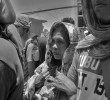Indeed, climate change is worsening and massive destruction is continuing. But, alas, the call for climate action and environmental protection remains unheard of in our country. Instead of taking measures to protect the environment and creating counter-measures to further prohibit environmental degradation, the call for our nature’s protection has now escalated into a full-blown attack on human rights violations.
By BEVERLY ANN S. MUSNI, YR.
Contributor
As the wind howled furiously, carrying with it rooftops, debris from houses and toppling even the most sturdiest of trees and electrical posts, there is no denying that the typhoon Pablo had with it the fierce wrath enough to pummel Northern and Central Mindanao. In a haunting rewind of last year’s typhoon Sendong, hundreds have been declared dead, hundreds more are missing. As the first and worst typhoon ever experienced in Bukidnon, I can only watch its path of annihilation, helpless in the force of nature.
Indeed, climate change is worsening and massive destruction is continuing. But, alas, the call for climate action and environmental protection remains unheard of in our country. Instead of taking measures to protect the environment and creating counter-measures to further prohibit environmental degradation, the call for our nature’s protection has now escalated into a full-blown attack on human rights violations.
By favoring the foreign-market investments and development projects, the Aquino administration has endangered the lives of thousands of civilians, especially those who are advocates of genuine agrarian reforms and environmental protection. Bukidnon –whose lush forests and mountains are home to rich deposits like gold, magnesium and other valuable minerals — is now in the middle of an environmental and human rights slaughter. The agri-business expansion and large-scale mining activities have greatly caused rights violations especially extrajudicial killings. From 2010 up to the present, under President Benigno Aquino III’s term, 159 cases of human rights violations have occurred in Bukidnon. Among the victims of extrajudicial killings, five out of six were environmentalists and Lumad leaders.
Dao Brgy. Captain Jimmy Liguyon, an anti-large-scale mining advocate, was gunned down in his home last March 5, in front of his daughter, because of his refusal to sign a local resolution allowing the entry of multi-national mining activities in their area in San Fernando, Bukidnon. The mining concession San Cristo Mines acquired an exploration permit over 13, 756.68 hectares in the area.
Witnesses and Liguyon’s family accused the paramilitary group New Indigenous Peoples Army Reform (Nipar) as responsible for his death. Said para-military group continues to threaten the residents, agitating them to struggle and hold a camp-out at the Malaybalay Provincial Office to seek help and government intervention.
On October 10, at around 6 o’ clock in the morning, Datu Erning Mantugohon, also a staunch advocate against large-scale mining in San Fernando, Bukidnon, was found dead in his workplace. Sustaining multiple head wounds and his neck tied with a pump belt, he was, according to witnesses, killed by Nipar and Special Civilian Armed Auxiliary members.
With the spate of killings and threats, the residents of San Fernando have no choice but to flee and seek help from the provincial government of Bukidnon. But instead of assistance, Governor Alex Calingasan said the protest action ‘impedes the normal functions of government offices.’ He signed Executive Order (EO) No. 87, implementing stricter regulations regarding the assembly or protest actions of individuals or groups or creating infrastructures within the compound of the provincial Capitol.
Limited to placards, streamers and tents, the struggling evacuees were treated now like vagrants — they who were already driven away from their lands and now currently camping.
According to the constitutional provisions to freedom of speech and assembly, the act of the provincial government runs opposite to the law. The group firmly believes that the state should not create laws which will curtail the exercise of the basic right to protest and seek redress because of their grievances.
Environmentalist Margarito “Boy” Cabal, an instrument in the anti-hydro mega dam movement in Southern Bukidnon and Cotabato was also silenced forever. He was very vocal against the construction of the Pulangi-V Hydro Mega Dam Project, educating and organizing the communities in that area to lobby against the project which would inundate around 22 communities and affecting thousands of individuals.
The death of these environmentalists and human rights activists prove that no matter how the Aquino government projects itself to follow the “Matuwid na Daan” principle, it only portrays the continuous brutality of the state under the guise of development.
Worse, as the environmental onslaught continues to plague thousands in Southern Mindanao Provinces, mining conglomerates and agri-business giants continue the destruction of our forests and lands. The Aquino government is no different from the Arroyo government, if not worse. No concrete action from the Aquino administration can still be made out if human rights issues remain unresolved and environmental plunder worsens.
As the death toll of the victims of typhoon ‘Pablo’ increases, we can only watch in helpless resignation of the horror and the indescribable devastation it brought. The worst is yet to come. (end)

![[STANDPOINT] Illegal drugs and the NIMBY mindset](https://davaotoday.com/wp-content/uploads/2016/09/Mags-Maglana_UPMIN-Sept.-20-110x100.jpg)








